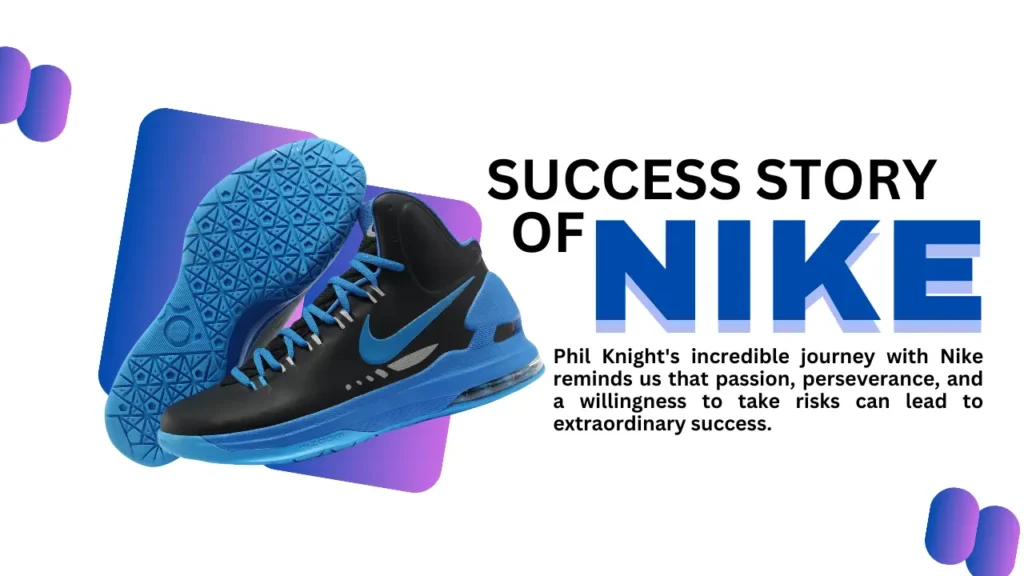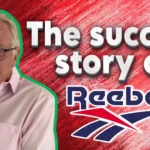Nike is the world’s largest sportswear brand, earning around a thousand crore rupees daily. World-class athletes like Ronaldo and Rafael Nadal use their products. Would you believe that the person who built Nike was a failed athlete himself? He started his business by selling shoes from the trunk of his car. This is the story of Nike’s founder, Phil Knight.

Table of Contents
Early Life
Phil Knight was born in 1938 in Portland, Oregon, America. Since childhood, he has been known for his speed; his ultimate dream was to become a great athlete. In school and college, he worked hard on his running and won many races. Along with running, Phil continued his education, completing his MBA in 1962.
He still wanted to pursue running but faced a harsh reality one morning while practicing. After dedicating his youth to the sport, he became one of the best athletes in his state, but he could not reach the national or international level. Sadly, he was good but not great. At twenty-four years old, he realized there was little room for improvement in athletics. With a heavy heart, Phil accepted that this was the end of his athletic career.
Entering the Shoe Business
Though he failed to become an elite athlete, he wanted to remain connected to sports. Phil was deeply attached to his running shoes, just like every runner. That’s why he decided to enter the shoe business. He remembered that during his MBA, he had studied for several weeks and written a detailed research paper on the business of running shoes. In his research, he discovered that Japanese camera companies had disrupted the American market with their improved quality and low prices. He hypothesized that Japanese shoes could similarly disrupt the American shoe market and potentially overtake Adidas and Puma, the most prominent companies at the time.
The Beginning of Blue Ribbon Sports
Starting a business based on his college project was a considerable risk, but Phil had yet to find another option. He decided to import Tiger brand shoes from Japan and sell them in the USA. Tiger shoes were manufactured by a Japanese company named Onitsuka. Phil collected all his savings and took a flight to Japan. Once there, he secured an appointment with Onitsuka’s office. He was very nervous before the meeting. A shy, introverted young man was about to partner with a big company.
The First Meeting
At the beginning of the meeting, Onitsuka’s executive asked Phil for the company name. He wasn’t sure how, but he imagined the blue ribbons from his childhood—the same ribbons he had received for winning races. He said, “Blue Ribbon.” He claimed to represent Blue Ribbon Sports, even though no such company existed then. The Onitsuka executives were pleased with the name.
Building the Business
As the meeting progressed, Phil presented his college project line by line. By the end, Onitsuka’s employees were so impressed that they wanted his company, Blue Ribbon, to sell Tiger shoes in America. It was a deal! Phil provided his address and asked them to send some Tiger training shoe samples. He was ecstatic and transferred money to Onitsuka for the shoe samples before returning to America to wait.
Challenges and Breakthroughs
Four months passed, and he still had not received any shoes. In response to his inquiries, Onitsuka assured him the boots would arrive soon, but that did not happen. Phil had not given up hope but needed a job to survive until the shoes arrived. He took a job as an accountant at a firm. Almost a year after he met with Onitsuka, Phil had nearly lost hope when he received a notice from customs: there were twelve shoes from Japan.
After collecting the shoes, Phil unboxed them and showed them to his college coach, Bill Bowerman. He explained his business plan, and Bowerman liked the boots so much that the very next day, he offered Phil a 50% partnership. Phil was entirely surprised by this offer. Bowerman had been obsessed with shoes throughout his coaching career and became a shoe design expert. His focus was on making shoes lighter. He would often take his students’ shoes without asking, modify them, and return them after making adjustments. The athletes’ performance would massively improve after his modifications.
The Partnership
Bill Bowerman was also a genius coach and a natural leader. He was a god-like figure for Phil and the other runners. Today, the exact figure wanted to become Phil’s business partner. It was a no-brainer. They shook hands and became equal partners. That same day, Phil wrote a letter to Onitsuka, asking for exclusive distribution rights to sell Tiger shoes in Western USA. He also placed an order for 300 shoes for $1,000.
The shoes arrived on time, and Blue Ribbon secured exclusive distribution rights for Western USA. Phil immediately quit his accounting job to focus entirely on the business. He stored the shoes in the basement of his parents’ house, which became the office of Blue Ribbon. It was time to sell shoes. Phil approached many sports shops, but everyone refused to sell Tiger shoes. Lacking funds to open his shop, he came up with a plan: he filled the trunk of his car with shoes and started attending athletic competitions.
Sales Success
He spoke to coaches, athletes, and spectators, presenting his shoes. Although Phil had tried sales before without success, the customers’ response shocked him this time. His shoes were selling like hotcakes. As a former athlete, he understood the problems athletes faced and could easily convince customers that Tiger shoes were their best option.
In just two months, he sold the first shipment of 300 shoes and ordered 900 shoes this time. However, his total earnings were only $2,000, while the order cost $3,000. Phil requested a $1,000 loan from the bank for the first time. Seeing Blue Ribbon’s strong business, the bank approved the loan, and Phil finally had a career he sincerely enjoyed. He had a trusted partner in Bill Bowerman and a product selling well.
Setbacks and Recovery
However, a twist awaited him. A wrestling coach wrote to Phil, claiming he had just returned from a meeting with Onitsuka in Japan and had been given exclusive distribution rights for all of America. Only two months had passed since Phil started his business, and he was on the verge of closure. He immediately wrote to Onitsuka for clarification, but there was no response. Determined, Phil decided to go to Japan and confront Onitsuka.
During the meeting, he explained how he had been wronged, presented his strong sales arguments, and shared his plans. The next day, he met with the company owner, Mr. Onitsuka. The owner instantly trusted Phil, stating that Phil’s passion reminded him of his youth. He granted Phil the Western USA distributorship again. Phil felt relieved, but the problems were far from over. Blue Ribbon achieved $8,000 in sales by the end of its first year. They hired a salesman named Jeff Johnson to expand into another city. Jeff, also an athlete, was extremely passionate about his work, which helped sales reach $16,000 in the second year.
The Debt Crisis
However, this growth became a significant problem. Phil wanted to expand quickly, so whenever one shipment sold out, he would double or triple the following order. They had to reinvest their entire profit to pay for the orders and even take out loans from the bank. After one year of business, Blue Ribbon incurred significant debt. With negative cash flow, the bank refused to give them further loans, leaving Phil scrambling for money to keep Blue Ribbon alive. To survive, he worked as an accountant at PwC, investing his entire salary into the business.
Innovations in Shoe Design
Meanwhile, Bill Bowerman was working to improve Tiger shoes. He realized the American foot was longer and heavier than the Japanese foot, necessitating a different shoe design. Bowerman conducted several experiments and combined the best features of different Tiger shoes to create an ultimate distance training shoe for Americans, naming it the Cortez. Onitsuka began manufacturing the Cortez shoes, which became a massive success as soon as they entered the American market. Thanks to Phil’s management and Bowerman’s shoe design, Tiger Shoes became one of the top brands in America within five years. Sales reached $1.3 million by 1971, and the business doubled yearly. Phil then quit his job and joined Blue Ribbon full-time.
A New Challenge
Just as things were going perfectly, a huge blow came from Japan. Seeing Blue Ribbon’s success, Onitsuka became greedy and wanted to take all the income from Tiger shoes for themselves. They issued an ultimatum to Phil: if he didn’t sell them 51% of Blue Ribbon’s stake, they would give the American distributorship to someone else. Phil was shocked and hurt; it felt like a betrayal.
A Bold Decision
Determined not to let this fraud continue, Phil made a monumental decision. He gathered his team and declared that the time to sell someone else’s brand was over. Now was the time to create their brand! With this resolve, he ended the partnership with Onitsuka and decided to manufacture shoes under their brand.
The Creation of Nike
The first step was to create a new logo. Phil wanted the logo to evoke a sense of motion and victory while fitting the side of the shoe. He hired a graphic design student, who presented several designs after a few days. The team selected a curved logo resembling a thick check mark. Phil thanked the student and paid a fee of $35.
Next came the choice of a brand name. Many names were suggested, including Falcon and Dimension 6. However, Jeff Johnson thought of the name “Nike,” inspired by the Greek goddess of victory. Phil loved the name and immediately registered it.
The Launch of Nike
On January 25, 1972, they officially launched the Nike brand and began manufacturing shoes. The company started gaining popularity quickly but still faced an uphill battle. Nike was still an unknown entity, and the company needed an effective marketing strategy to get noticed. Phil had to compete with giants like Adidas, Puma, and Tiger.
Athlete Endorsements
To combat this challenge, Phil devised a unique marketing strategy. He recognized that runners preferred shoes endorsed by top athletes. Phil struck a deal with runner Steve Prefontaine to promote Nike for $5,000 annually, making Nike one of the first brands to utilize athlete endorsements as a marketing strategy.
Selecting a Sales Team
Phil’s second strategy involved carefully selecting his sales team. Nike hired individuals who were either athletes or highly passionate about sports. This approach helped the sales team better understand the needs of their athletic customers, leading to improved product design and customer service.
The Rolls-Royce: Success, History, Case Study
Audi Success Story: Case Study of Audi and Future of Luxury Mobility
Mercedes-Benz: World’s First Car Success Story
Ford Sucess Story: The Incredible Rise of Henry Ford
Rapid Growth
As a result of these strategies, Nike proliferated, employing 2,700 people by 1980 and recording sales of $270 million, surpassing Adidas and establishing itself as the most prominent athletic company in the USA. Phil felt he had created the strongest athletic brand in the country.
A New Competitor: Reebok
However, a new competitor, Reebok, emerged, posing a significant threat to Nike. While Nike focused on performance, Reebok capitalized on the fashion aspect of athletic shoes, creating stylish options that appealed to consumers. As a result, customers began to disconnect from Nike. The company experienced losses for the first time and had to lay off employees. In 1986, Reebok surpassed Nike, becoming the largest athletic shoe company.
The Michael Jordan Strategy
In response to this challenge, Phil turned to a rising star in basketball: Michael Jordan. Recognizing Jordan’s potential, he signed him as a brand ambassador and launched basketball sneakers named Air Jordan. Before Air Jordan, basketball shoes were plain, but this bold design transformed the market. Michael Jordan promoted the shoes by wearing them during games, and Nike released ads featuring him with the tagline “Air Jordan, it’s all in the imagination.”
Phenomenal Success
Nike sold $100 million worth of Air Jordans in the first year, allowing them to overtake Reebok. The Air Jordan brand boosted Nike’s sales and revolutionized sneaker culture.
Global Expansion
Throughout the 1990s, Nike continued to expand globally, entering new markets and diversifying into various sportswear categories beyond shoes. Today, Nike is valued at around ₹12 lakh crore, solidifying its status as the world’s largest sportswear brand.
Phil Knight and Nike’s journey is truly phenomenal! The most important lesson from this journey is execution. In his book Shoe Dog, Phil said, “Let everyone call your idea crazy. Just keep going. Don’t stop. Don’t even think about stopping until you get there.” No matter what anyone says, if you are passionate about an idea, take calculated risks and execute it. Nike’s tagline reflects this ethos: “Just do it.”
Now, we want to hear from you! Have you ever faced challenges in pursuing your dreams? What lessons have you learned along the way? Please share your experiences in the comments below, and let’s spark a conversation about resilience and innovation in our own lives. Your insights could inspire others to “Just do it,” too!










